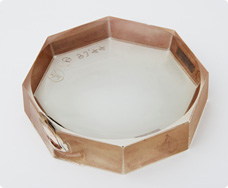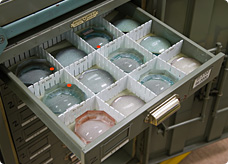A "test plate" represents the standard surface shape of the lens. The quality of the lenses installed in optical devices such as cameras, telescopes and microscopes has a major effect on performance. High-precision test plates are vital for achieving top-class optical performance.
What is a test plate?
A test plate is made out of transparent glass material, and its curved surface represents a pattern for the surface of the lens. Since the surface of a normal lens is a section of a spherical surface, test plates are categorized in terms of the radius of the sphere, or "R." For example, "R20" denotes a spherical surface of a radius of 20 millimeters. The higher the figure, the gentler the curvature, and the lower the figure, the sharper the curvature.
There are two types of test plates—the "master test plate" and the "production test plate." A production test plate (whose curvature has been accurately reproduced from the original test plate) is used at the production site where the lens is manufactured.

Master test plates

Production test plate (which has non-slip rubber affixed to the periphery in order to improve work)

Production test plates (for lenses only a few millimeters in diameter)
Lens polishing and the production test plate
Lens polishing is an operation in which optical glass is rubbed against polishing plates. Convex lenses are polished with a concave polishing plate, while concave lenses are polished with a convex plate. The surface shape of the polishing plate reflects the shape of the lens. The shape of the lens' surface is checked closely using the production test plate.
In the lens polishing process, the operator removes the lens from the lens polisher and matches it up with the production test plate. The operator then looks for "Newton rings" that appear between the surface of the lens and the production test plate. It is possible to judge the precision of the lens surface from the appearance of these Newton rings. The Newton rings are checked in order to verify the progress of the polishing as it is taking place, and to check the precision of the surface of the lens after polishing has been completed.

The lens polishing process

Production test plate (above) and lens (below) are fitted together to confirm the accuracy of their surfaces.
Newton rings

Newton rings
Newton rings are caused by the mutual interference between the light reflected by the curved surface of the lens and the light reflected by the curved surface of the test plate in the layer of air between the lens and the test plate. These interference patterns are called Newton rings after their discovery by Sir Isaac Newton.
If the curved surfaces of the lens and the test plate are absolutely identical, no air will enter between them and no Newton rings will appear. On the other hand, the thicker the air layer (that is, the larger the discrepancy between the curved surfaces of the lens and the test plate), the more stripes there will be. Inspectors utilize this property and verify the degree of precision of the polishing from the number of rings.
How lens production started

Master test plate manufactured in the 1950s. The brown on the rim is from red iron oxide, which was used at the time as an abrasive. These are now preserved in Nikon's historical archives.
Nippon Kogaku K.K. (Nikon) was established in July 1917, after which it took over the operations of the optical measuring instruments division of Tokyo Keiki and the reflector division of Iwaki Glass in August, and all departments (including developing, manufacturing and marketing ) of Fujii Optical Works in December. Hence, Nikon inherited its lens production from Fujii Lens.
Ryuzo Fujii, the founder of Fujii Lens, studied optical science by reading technical books from Europe and assiduously pursued independent research by visiting optical instrument manufacturers in Germany.
Fujii Lens began manufacturing lenses and prisms in 1909. The following year, they imported a polishing machine, a centering machine, a glass-cutting machine, curvature measurement instruments, and spectroscopes from Germany, and established a factory for optical products. Production of test plates, required for lens manufacturing, also started at this time.
After Nippon Kogaku K.K. took over the operations of Fujii Lens, Ryuzo Fujii held a succession of senior posts at the company.
Technical guidance from German engineers
In 1921, Nippon Kogaku K.K. engaged eight German engineers, posting four of them to the Ohi factory (now the Ohi Plant) and four of them to the Shiba factory (no longer in existence). The eight were brought to Japan by Mr Fujii, who had personally recruited and interviewed them in Germany and negotiated their employment conditions. The expertise which the German engineers passed on brought about major improvements in manufacturing techniques and product quality.
According to Forty Years of Nippon Kogaku K.K., three of the German engineers—Adolf Sadtler, Albert Ruppert and Karl Weise—gave guidance on working and polishing glass. The book also records that Herr Ruppert was transferred from the Ohi factory to the Shiba factory and directed the polishing of test plates.
The lens manufacturing that Nikon had inherited from Fujii Lens was greatly improved under the direction of the German engineers. Numerous engineers have subsequently further modernized production methods, and these kinds of advances continue to this very day.

Characters such as "θ" "Y" and "N" can be seen on these old master test plates, as well as the "R" number. It is said that these characters were put there by the German engineers for technical guidance.
A test plate is an optical instrument manufacturer's treasure

Master test plates in storage

A large number of master test plates are kept at the Jigtec depository.
Because the master test plates are such crucial items in lens production, a robust depository has been set up in a durable building and continues to be administered, so that they will not suffer damage from fires or earthquakes.
Master test plates are currently safeguarded by Jigtec, a Nikon group company. Jigtec manufactures production test plates based on the masters, and supplies them to lens polishing departments within the Nikon group.
Nikon has a history of over 90 years of optical instrument manufacturing, and since its founding, the number of its products has continued to grow. Manufacturing a wide variety of optical products has required a wide variety of lenses. Master test plates have been made to address this demand. As testimony to the manufacture of various optical products, the numerous master test plates in Nikon's possession are an optical instrument manufacturer's treasure.

